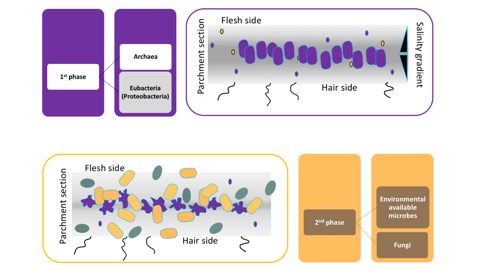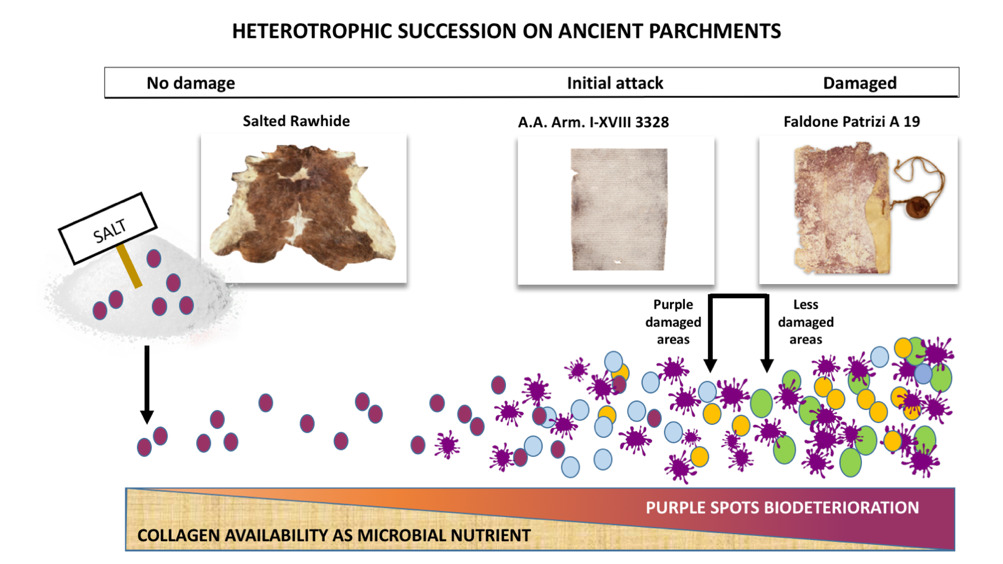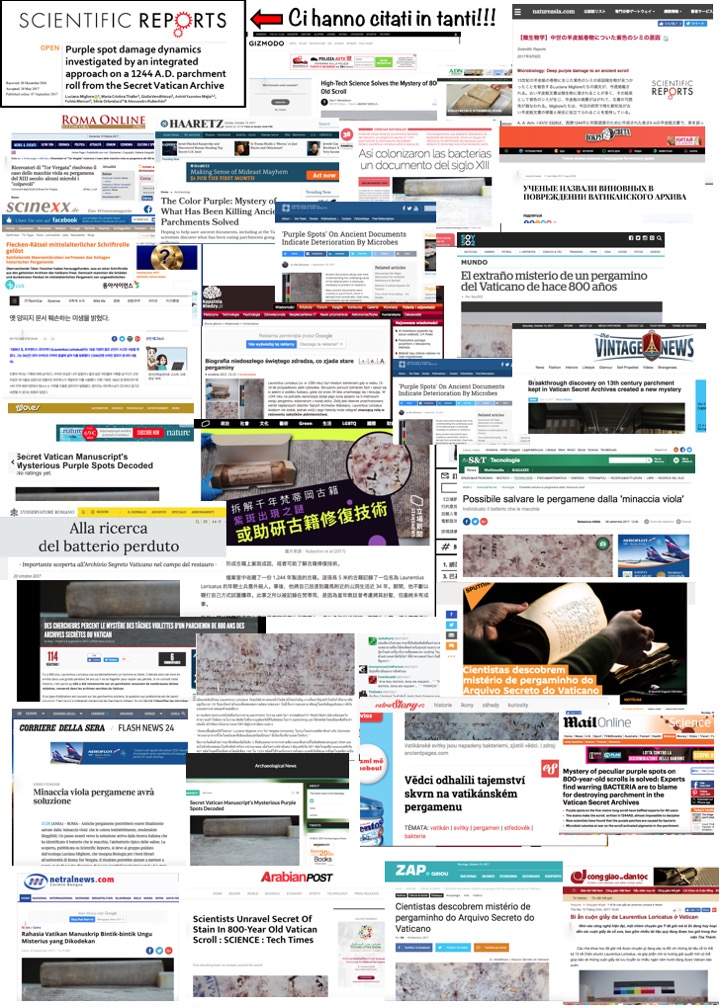MODELS OF BIODETERIORATION OF ANCIENT PARCHMENTS AND MODERN RAWHIDES
Parchments were produced from animal skin and consists in the dermal skin layer and are often defaced by purple spots associated with localized destruction of collagen fibres.
The first approach to the study of bacterial biodeterioration of parchments involved a five meters long 1244 D.C. parchment roll preserved in the Vatican Secret Archives. It was written for the preliminary phase of the canonization process of the Blessed, Lorenzo Loricato. This roll was damaged by purple spot, causing flaking of the parchment and loss of ink and readability. The study of this precious document included different approaches: a physical one, to characterize the structure and conservation of the parchment; a metagenomic one, to identify the microorganisms responsible of the attack and a chemical one, to identify the composition of the purple spots. The metagenomic approach has been aimed to identify the microbial colonizer of the purple areas by Next Generation Sequencing (454-pyrosequencing).

The integration of these approaches allowed us to hypothesize a colonization model (in Figure) which explains why this purple stain type of deterioration is common to documents with different ages and individual stories.
A second study involved three very damaged parchments belonging to another collection of the Vatican Secret Archives, Faldone Patrizi A 19 dated back XVI-XVII century A.D., with the same multidisciplinary approach. Next Generation Sequencing (Illumina platform) revealed DNA sequences belonging to the archaea, Halobacterium salinarum; RAMAN spectroscopy identified the pigment within the purple spots as haloarchaeal bacterioruberin and bacteriorhodopsine, and Light Transmission Analysis quantified the very high damage to the collagen structures through the entire parchments. Again, the integration of these results allowed to propose a final model of the progressive degradation pattern of the parchment collagen. Overall, these data validate the multi-phase microbial succession model shown in the following Figure.

Both articles have been published in the Nature Group Journal, Scientific Reports; the first one has attracted a great media interest: online there have been over 100 articles published in 18 languages, from the oriental ones (Chinese, Japanese, Indonesian, Korean and Thai), to Russian, Galician, Brazilian, to mention only the least expected ...

The dynamics of the colonization process have been framed in the theoretical ecological framework: the two-phase succession corresponds to and supports the two main theories on ecological succession hypothesized at the beginning of the 20th century by Clements (1916) and Gleason (1926). In fact, according to Clements' hypothesis the first phase is fairly conservative, it is always triggered by the halophilic haloarchea - directly responsible for the purple spots - and continues with opportunistic halo-tolerant heterotrophs, i.e. Vibrio. Differently, the second phase, according to Gleason's hypothesis, depends on the environment available microbes that may colonize the damaged parchment (already attacked by the first phase microbes), therefore the final colonizers vary between the different documents, depending on the environmental pool.
We also studied the raw material, i.e. animal hides, which have been used for centuries for very many purposes, due to the peculiar mechanical properties of the hides. Due to their animal origin, even rawhides undergo microbial attacks and biodeterioration. Traces of colonization can be clearly found in chrome tanned leathers (in the wet blue phase), causing significant economic damage: tanned skins often show isolated or coalescent red spots, known as red heat deterioration. We studied the dynamics of biodeterioration and its effects on the stability/integrity of the collagen structures on chrome tanned leathers by using standard microbiology methods, alongside the three technologies used on parchments. These data also allowed to evaluate whether skins and parchments share responsible and effects of biodeterioration. The comparison of chrome-tanned leathers and historical parchments, as regards both colonizing microorganisms and effects on collagen properties, allowed to highlight that the dynamics of rawhide colonization is the same of parchment; the difference depends on the chromium treatment that not only kills all the colonizers (stopping the succession at its first stage), but also generates cross-links in the structure of the damaged collagen, restoring its stability and integrity.
All this work has been done in collaboration with the colleagues teaching at the Master Degree in Conservation and Restoration of Cultural Heritage: Fulvio Mercuri, Department of Industrial Engineering, Silvia Orlanducci, Department of Chemistry, and Alessandro Rubechini, Vatican Apostolic Archives (ex Secret Archves). We all are indebted to H. Exc. Most Rev. Mons. Sergio Pagano, Prefect of the Archives, who gave us the unique opportunity to work in the incredible context of the Archives, among its kilometers of shelving and thousands of documents. A special thank is due to Domenico Castiello and Valerio Talarico of the Po.Te.Co (Polo Tecnologico Conciario, s.c.r.l., Santa Croce sull’Arno, Italy) who supported the work on rawhides and significantly collaborated to both the technical and the conceptual dimensions of the study.
Perini N., Mercuri F., Orlanducci S., Thaller M.C., Migliore L. (2020). THE INTEGRATION OF METAGENOMICS AND CHEMICAL PHYSICAL TECHNIQUES BIODECODED THE BURIED TRACES OF THE BIODETERIOGENS OF PARCHMENT PURPLE SPOTS. Frontiers in Microbiology, 11:598945. DOI: 10.3389/fmicb.2020.598945
Ancient parchments record an immense part of our cultural heritage, having been used as the main written support material for centuries. Parchment easily undergoes biodeterioration, whose main signs are the so-called purple spots, which often lead to detachment of the superficial written layer. Up to recent years, several studies have been analyzing damaged parchments from different world’s archives, trying to trace back the culprit of the purple spots. However, standard cultivation and early molecular techniques have been demonstrated to be unsuccessful, leading the parchment damage issue remaining unsolved for many years. Nowadays, some studies have explored the parchment biodeterioration dynamics by adopting a multidisciplinary approach combining standard microbiological methods with high-throughput molecular, chemical and physical techniques. This approach allowed an unprecedented level of knowledge on the complex dynamics of parchment biodeterioration. This mini review discusses the application of the combination of basic and high-throughput techniques to study historical parchments, highlighting the strengths and weaknesses of this approach. In particular, it focuses on how metagenomics has been paramount for the unequivocal identification of the microbial main actors of parchment biodeterioration and their dynamics, but also on how metagenomics may suffer the distortion inflict by the historical perspective on the analysis of ancient specimens. As a whole, this mini review aims to describe the scenario of information on parchment biodeterioration obtained so far by using the integration of metagenomic with recent chemical (Raman spectroscopy) and physical (Light Transmission Analysis) approaches, which might have key implications in the preservation of many ancient documents.
Perini N., Mercuri F., Thaller M.C., Orlanducci S., Castiello D., Talarico V., Migliore L. (2019) - THE STAIN OF THE ORIGINAL SALT: RED HEATS ON CHROME TANNED LEATHERS AND PURPLE SPOTS ON ANCIENT PARCHMENTS ARE TWO SIDES OF THE SAME ECOLOGICAL COIN. Frontiers in Microbiology, 10:2459. DOI: 10.3389/fmicb.2019.02459
Animal hides are one of man’s earliest and mostly used material; many rawhide products, primarily leather, are used for several purposes since centuries. The peculiar mechanical properties of leather made it material of choice for many different applications and goods; consequently, leather industry had a great success in all human cultures. Unfortunately, due to their animal origin, rawhides may undergo microbial attack and biodeterioration; but in the centuries, different processes and treatments (brining, vegetal or chrome tanning, tawing, etc.) were set up to face the biological attack and modify/stabilize the hide mechanical properties. Nevertheless, even present-day rawhides are subjected to biological colonization and traces of this colonization are clearly shown in chrome tanned leathers (in the wet blue stage), with obvious economic damages; tanned leathers often show isolated or coalescent red patches, known as red heat deterioration.
Even parchments, hide product which derive from another manufacturing procedure, undergo microbial attack and biodeterioration. A frequent ancient parchment alteration, called purple spots, show signs of biodeterioration comparable to the red heat deterioration. Recently, an ecological succession model explained the process of historical parchment purple spot deterioration, suggesting the haloarchaea H. salinarum as the triggering pioneer organism of this biological attack; salting of hides – to prevent the hide from rotting – has been identified as the responsible for haloarchaeal colonization (Migliore et al., 2019).
The aim of this study was to investigate the dynamics of biodeterioration on chrome tanned leathers and its effects on the stability/integrity of collagen structure. To this end, standard cultivation methods were integrated with three updated technologies, including Next Generation Sequencing, RAMAN spectroscopy and Light Transmitted Analysis. Moreover, to evaluate if leather and parchment share common culprits and effects of the biodeterioration, a comparison between chrome tanned leather vs historical parchments was performed, as regard both the colonizing microorganisms and effects on the physical properties of the hide product.
Migliore L., Perini N., Mercuri F., Orlanducci F., Rubechini A., Thaller M.C. (2019) - THREE ANCIENT DOCUMENTS SOLVE THE JIGSAW OF THE PARCHMENT PURPLE SPOT DETERIORATION AND VALIDATE THE MICROBIAL SUCCESSION MODEL Scientific Reports, 9: 1623. DOI: 10.1038/s41598-018-37651-y
The preservation of cultural heritage is one of the major challenges of today’s society. Parchments, a semi-solid matrix of collagen produced from animal skin, are a significant part of the cultural heritage, being used as writing material since ancient times. Due to their animal origin, parchments easily undergo biodeterioration: the most common biological damage is characterized by isolated or coalescent purple spots, that often lead to the detachment of the superficial layer and the consequent loss of written content. Although many parchments with purple spot biodegradative features were studied, no common causative agent had been identified so far. In a previous study a successional model has been proposed, basing on the multidisciplinary analysis of damaged versus undamaged samples from a moderately damaged document. Although no specific sequences were observed, the results pointed to Halobacterium salinarum as the starting actor of the succession. In this study, to further investigate this topic, three dramatically damaged parchments were analysed; belonging to a collection archived as Faldone Patrizi A 19, and dated back XVI-XVII century A.D. With the same multidisciplinary approach, the Next Generation Sequencing (NGS, Illumina platform) revealed DNA sequences belonging to Halobacterium salinarum; the RAMAN spectroscopy identified the pigment within the purple spots as haloarchaeal bacterioruberin and bacteriorhodopsine, and the LTA technique quantified the extremely damaged collagen structures through the entire parchments, due to the biological attack to the parchment frame structures. These results allowed to propose a model of the progressive degradation pattern of the parchment collagen. Overall, these data validate a multi-phase microbial succession model. This demonstration is pivotal to possible new restoration strategies, important for a huge number of ancient documents.
Migliore L., Thaller M.C., Vendittozzi G., Mejia A.Y., Mercuri F., Orlanducci S., Rubechini A. (2017) - PURPLE SPOT DAMAGE DYNAMICS INVESTIGATED BY AN INTEGRATED APPROACH ON A 1244 A.D. PARCHMENT ROLL FROM THE SECRET VATICAN ARCHIVE. Scientific Reports, 7: 9521 DOI: 10.1038/s41598-017-05398-7
Ancient parchments are commonly attacked by microbes, producing purple spots and detachment of the superficial layer. Neither standard cultivation nor molecular methods (DGGE) solved the issue: causative agents and colonization model are still unknown. To identify the putative causal agents, we describe the 16 S rRNA gene analysis (454-pyrosequencing) of the microbial communities colonizing a damaged parchment roll dated 1244 A.D. (A.A. Arm. I-XVIII 3328, Vatican Secret Archives). The taxa in damaged or undamaged areas of the same document were different. In the purple spots, marine halotolerant Gammaproteobacteria, mainly Vibrio, were found; these microorganisms are rare or absent in the undamaged areas. Ubiquitous and environmental microorganisms were observed in samples from both damaged and undamaged areas. Pseudonocardiales were the most common, representing the main colonizers of undamaged areas. We hypothesize a successional model of biodeterioration, based on metagenomic data and spectroscopic analysis of pigments, which help to relate the damage to a microbial agent. Furthermore, a new method (Light Transmitted Analysis) was utilized to evaluate the kind and entity of the damage to native collagen. These data give a significant advance to the knowledge in the field and open new perspectives to remediation activity on a huge amount of ancient document.
Migliore L., Vendittozzi G., Mejia A.Y., Mercuri F., Carbonetti C., Thaller M.C., Romani M., Cicero C., Orazi N., Pasqualucci A., Marinelli M., Rubechini A. (2016) - IL ROTOLO A.A., ARM. I-XVIII 3328 DELL’ARCHIVUM ARCIS: STUDI LETTERARI E SCIENTIFICI, INTERVENTI DI RESTAURO. Dall’Archivio Segreto Vaticano. Miscellanea di testi, saggi e inventari, IX: 403-421. Click here to read the article